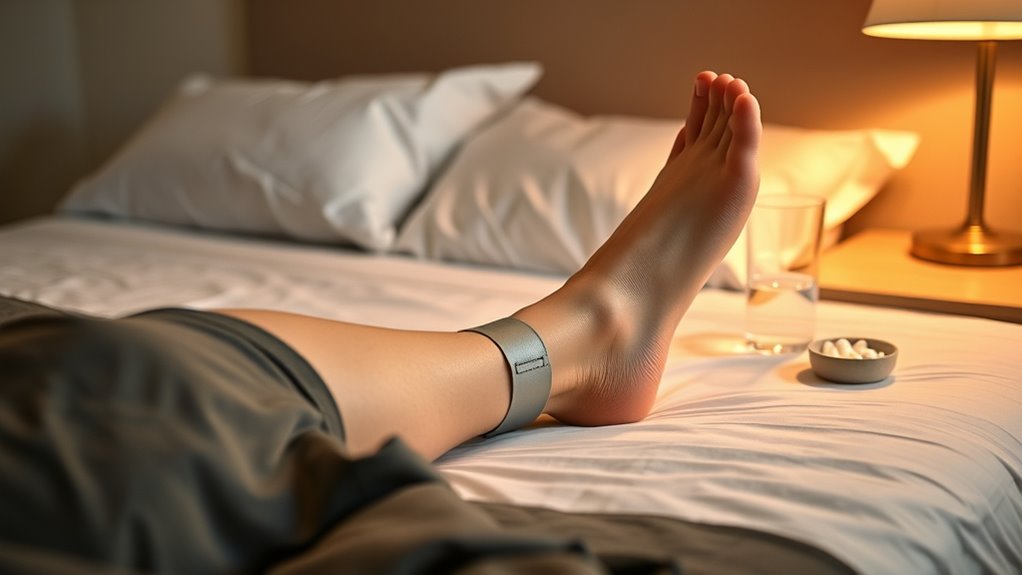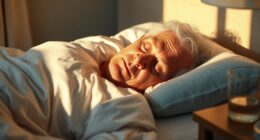To reduce nighttime leg cramps, make certain you’re staying well-hydrated and eating a balanced diet rich in electrolytes like potassium, magnesium, and calcium. Incorporate daily stretching, especially for your calves and hamstrings, before bed. Maintain an active lifestyle with moderate exercise and wear proper footwear. Create a relaxing sleep environment, avoiding overexertion late in the day, and include gentle stretches in your bedtime routine. Keep exploring for more tips to keep cramps at bay.
Key Takeaways
- Maintain proper electrolyte balance by consuming foods rich in potassium, magnesium, and calcium to prevent cramps.
- Stay well-hydrated throughout the day, especially before bedtime, to support muscle function.
- Incorporate regular stretching exercises targeting calves and hamstrings into your nightly routine.
- Wear comfortable footwear and avoid overexertion during the day to reduce muscle fatigue at night.
- Create a relaxing sleep environment and perform gentle stretches before bed to promote muscle relaxation.

Nighttime leg cramps can disrupt your sleep and leave you feeling sore and exhausted the next day. These involuntary muscle contractions often strike without warning, making it hard to get restful rest. To tackle this issue, you need to focus on strategies that address the root causes, starting with maintaining a proper electrolyte balance. Electrolytes like potassium, magnesium, and calcium are essential for muscle function, and deficiencies can increase your risk of cramps. You can improve your electrolyte levels by eating a balanced diet rich in fruits, vegetables, nuts, and dairy products. If needed, consider electrolyte supplements, but always consult your healthcare provider before adding them to your routine. Staying hydrated is equally important, as dehydration can throw off your electrolyte balance and make cramps more likely. Drink plenty of water throughout the day, especially if you’re active or live in a hot climate.
Maintain a balanced diet with fruits, vegetables, nuts, and dairy to support electrolyte health and prevent cramps.
In addition to dietary adjustments, incorporating stretching exercises into your daily routine can markedly reduce the frequency and severity of nighttime cramps. Stretching helps relax tight muscles and improves flexibility, making cramps less likely to occur during the night. Focus on gentle stretches that target your calves and hamstrings—areas most prone to cramping. For example, standing calf stretches against a wall or sitting with your legs extended and reaching for your toes can be effective. Make stretching part of your pre-bedtime routine, holding each stretch for at least 20 seconds. Doing so not only relaxes your muscles but also encourages better circulation, which can help prevent cramps from forming overnight. Additionally, understanding the importance of muscle health can motivate you to prioritize these preventative measures.
It’s also helpful to pay attention to your overall activity level. Regular moderate exercise can improve muscle strength and endurance, reducing the likelihood of cramps. However, avoid intense workouts close to bedtime, as they can cause muscle fatigue and trigger cramps. Proper footwear and avoiding overexertion during the day can also make a difference. If you find yourself experiencing cramps frequently, consider adjusting your activity levels and stretching more often.
Finally, creating a comfortable sleep environment can help your muscles relax and recover overnight. Keep your bedroom cool, use supportive bedding, and ensure you’re in a comfortable position that doesn’t put strain on your legs. Taking these steps—balancing electrolytes, practicing stretching exercises, staying hydrated, exercising appropriately, and optimizing your sleep environment—can collectively reduce nighttime leg cramps and improve your sleep quality. With consistency, you’ll likely notice fewer cramps and wake up feeling more refreshed and less sore.
Frequently Asked Questions
Can Dietary Changes Help Prevent Leg Cramps?
Dietary changes can definitely help prevent leg cramps. If you’re experiencing cramps, you might have a magnesium deficiency or an electrolyte imbalance. Incorporate magnesium-rich foods like nuts, seeds, and leafy greens into your diet to support muscle function. Also, drink plenty of fluids and eat foods high in potassium and calcium to maintain electrolyte balance. These steps can reduce your chances of nighttime leg cramps naturally.
Are There Specific Medications to Reduce Nighttime Leg Cramps?
You might wonder about medication options for nighttime leg cramps. Some doctors recommend muscle relaxants or other medications to help ease the cramps, especially if they’re severe or persistent. These medications can relax your muscles and reduce cramping frequency. However, it’s essential to consult your healthcare provider before trying any medication, as they can recommend the safest and most effective options tailored to your needs.
How Does Hydration Affect Leg Cramp Frequency?
Ever notice how a glass of water sometimes eases your leg cramps? Hydration plays a key role in maintaining electrolyte balance, which helps prevent these painful spasms. When you’re well-hydrated, your muscles stay relaxed longer, reducing cramp frequency. Incorporating muscle relaxation techniques and drinking enough water keeps your electrolytes balanced, so you’re less likely to wake up with leg cramps. Staying hydrated is a simple but effective step in prevention.
Do Certain Sleeping Positions Increase Leg Cramp Risk?
Your sleeping posture can influence leg muscle tension, affecting your risk of cramps. If you sleep with your legs bent or crossed, it may increase tension in your leg muscles, making cramps more likely. To reduce this, try sleeping on your back or side with your legs straight, which helps relax muscles. Comfortably positioning your legs can minimize muscle tension and decrease nighttime leg cramp chances.
Can Leg Cramps Indicate Underlying Health Conditions?
Think of your body as a well-tuned engine; when you experience leg cramps, it might signal more than just muscle fatigue. These cramps can indicate underlying health conditions, often linked to electrolyte imbalance or dehydration. If cramps persist, they could symbolize deeper issues needing attention. Addressing electrolyte levels, staying hydrated, and consulting a healthcare professional can help you decipher these signs and keep your body running smoothly.
Conclusion
So, now that you’re armed with these foolproof tips, you can finally bid farewell to those midnight leg cramps. No more sneaking around, pretending you’re sleeping, while secretly wishing for a leg-free night. Just remember, if all else fails, you could always join the circus as a contortionist—at least then, cramps might be part of your act. Sweet dreams (and fewer leg spasms) are just a few simple tricks away!









